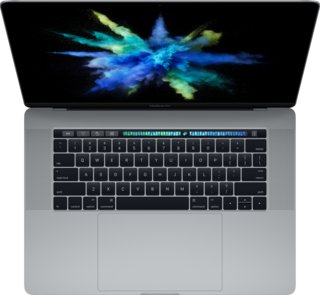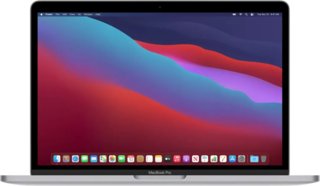Apple MacBook Pro (2016) 15" with Touch Bar and Touch ID vs Apple MacBook Pro (2020) 13.3" Apple M1
When deciding between the Apple MacBook Pro 2016 15" with the Touch Bar and Touch ID, and the Apple MacBook Pro 2020 13.3" with the M1 processor, each model presents specific strengths to cater to your individual requirements. The MacBook Pro 2016's larger 15-inch screen is ideal for creative professionals needing a wider display for design tasks, complemented by its integrated Touch Bar and Touch ID for enhanced usability.
In comparison, the MacBook Pro 2020 features Apple's newest M1 chip for increased performance, making it a top choice for those needing quick multitasking capabilities. It also provides sufficient memory with 8GB RAM and abundant storage space with a 512GB SSD. With its compact size, this model ensures enhanced mobility, ideal for students or users who are always traveling.
While both models deliver robust performance, your choice might boil down to whether you crave a grander display and have demanding graphical needs or if you value cutting-edge speed and easy mobility more.
System and application performance
Performance in popular 3D games
Viewing angle, color accuracy...
Ports, webcam and other interfaces
Potential battery life
Materials, durability and portability
Design Comparison
Size Comparison
# Comparing Apple MacBook Pro (2016) 15" with Touch Bar and Touch ID to Apple MacBook Pro (2020) 13.3" Apple M1.
Ergonomics and Portability
Apple MacBook Pro (2016) 15
- Weight: 4 pounds
- Size: 13.8 inches x 9.5 inches x 0.6 inches.
- Screen Size: 15.4 inches
- Thunderbolt Ports: 4
- USB Type C: Yes
Apple MacBook Pro (2020) 13.3
- Weight: 3.1 pounds
- Dimensions: 12" x 8.4" x 0.6"
- Screen Size: 13.3 inches
- Thunderbolt Ports: 2
- USB Ports: 2
Insights:- The Apple MacBook Pro (2020) is lighter and slightly smaller, enhancing portability for users who are often on the move or prioritize mobility.The newer model's fewer Thunderbolt and USB ports might limit connectivity options for users needing to connect multiple peripherals at once.
Materials and Build Quality
Both Models
- Backlit Keyboard: True
- Warranty Period: True
- Materials: Aluminum construction for durability
Insights:- Both laptops are constructed from aluminum, which provides a premium feel and durability, ensuring long-term use and protection from daily use.
Unique Design Features
Apple MacBook Pro (2016)
- Wi-Fi Version: 802.11ac (Wi-Fi 5), 802.11n (Wi-Fi 4)
Apple MacBook Pro (2020)
- Wi-Fi Versions: Include Wi-Fi 6 (802.11ax), Wi-Fi 5, and Wi-Fi 4.
- Bluetooth Version: Bluetooth 5
- Airplay Support
Insights:
- The upgraded Wi-Fi version and Bluetooth connectivity in the newer model reflect advancements in wireless technology, offering faster speeds and improved performance.
User Experience Perspectives
For Students:
- The Apple MacBook Pro (2020) is lightweight and convenient for students moving between classes. Meanwhile, the older model offers additional connectivity options that can be advantageous for users requiring multiple ports at once.
For Professionals:
- Professionals who need top-notch wireless connectivity may find the Apple MacBook Pro (2020) appealing for its enhanced Wi-Fi and Bluetooth features, facilitating smooth communication in meetings or presentations.
Aesthetic Appeal
Both laptops have a sleek and modern design that is characteristic of Apple products, conveying sophistication and elegance.
# Conclusion:
The Apple MacBook Pro (2016) focuses on providing a wide range of connectivity options, whereas the Apple MacBook Pro (2020) prioritizes enhanced portability and advanced wireless technology.
If you prioritize mobility and advanced wireless features, you may prefer the newer model. On the other hand, those needing more ports for multiple peripherals might find the older model better suited to their requirements.
Screen Comparison
| Apple MacBook Pro (2016) 15" with Touch Bar and Touch ID | Apple MacBook Pro (2020) 13.3" Apple M1 | |
|---|---|---|
| Resolution | QHD | QHD |
| Screen Size | 15.4" | 13.3" |
Apple MacBook Pro Screen Comparison: 2016 vs. 2020
In comparing the screens of the Apple MacBook Pro (2016) 15" with Touch Bar and Touch ID and the Apple MacBook Pro (2020) 13.3" with M1 chip, significant differences exist in screen size, resolution, brightness, and supported displays that impact user experience, especially for tasks like gaming or professional graphic design.
Screen Size:- The 2016 MacBook Pro has a 15.4-inch screen, which is larger than the 13.3-inch display on the 2020 model.- Professionals who work on multiple applications simultaneously or gamers who enjoy immersive gameplay benefit from a larger screen size, which offers more space for multitasking.
Resolution & Pixel Density:- The 2016 MacBook Pro has a resolution of 2880 x 1800 pixels, whereas the 2020 model features a resolution of 2560 x 1440 pixels.- The 2020 MacBook Pro boasts a slightly higher pixel density of 227 ppi on its smaller screen, surpassing the 220 ppi of the 2016 model.- Graphic designers rely on higher resolutions and pixel densities to achieve sharp images with accurate color representation and fine details.
Display Technology:- Both laptops have IPS LCD LED-backlit displays that provide vibrant colors and wide viewing angles.The display on the 2020 MacBook Pro shines brighter, reaching 500 nits, a notable improvement over the previous model.
- A brighter display enhances visibility in well-lit environments and makes content appear more vivid, benefiting users who work outdoors or in brightly lit spaces.
Supported Displays:- The 2016 MacBook Pro can connect with up to three external displays, whereas the newer model is compatible with two external displays.This feature benefits professionals needing extra screens for multitasking or extended desktop setups.
Impact on Tasks:- Gamers may enjoy a more immersive gaming experience with the older model's larger screen size.Graphic designers might find the improved resolution and pixel density of the latest model beneficial for intricate design tasks.
- Professionals who rely on multiple monitors may find the support for additional displays on the older MacBook Pro beneficial for enhanced productivity.
In conclusion, both laptops offer impressive display quality with their respective strengths in terms of screen size, resolution, brightness, and supported displays. Users should consider their specific needs such as multitasking requirements, visual precision in design work, or preference for brighter displays when choosing between these models.
Hardware Comparison
| Apple MacBook Pro (2016) 15" with Touch Bar and Touch ID | Apple MacBook Pro (2020) 13.3" Apple M1 | |
|---|---|---|
| RAM | 16GB | 8GB |
| Storage Size | 2000GB | 512GB |
The performance of the Apple MacBook Pro (2016) 15" with Touch Bar and Touch ID and the Apple MacBook Pro (2020) 13.3" with Apple M1 chip varies in practical applications due to differences in their hardware components.
CPU:
- 2016 MacBook Pro: The 2016 model boasts a CPU speed of 4 GHz, reaching up to 3.8 GHz with turbo clock speed.
- 2020 MacBook Pro: The 2020 model features the Apple M1 chip, offering a CPU speed of 4 GHz and a turbo clock speed of 3.5 GHz.
Impact on Performance: Both laptops feature powerful processors, with the newer M1 chip potentially delivering more efficient performance thanks to its advanced architecture and seamless integration with the macOS ecosystem.
GPU:
- 2016 MacBook Pro: The GPU specifications for the 2016 model are not explicitly provided in the given information.
- 2020 MacBook Pro: The Apple M1 chip in the 2020 model includes integrated graphics.
Impact on Performance: The integrated GPU in the M1 chip can handle multimedia tasks well, but may not be as powerful as discrete GPUs for heavy graphics-intensive software operations compared to dedicated GPUs found in some older models.
RAM:
- 2016 MacBook Pro: Comes with 16GB RAM.
- 2020 MacBook Pro: Offers two configurations
- one with 8GB RAM and another supporting up to a maximum of 16GB RAM.
Impact on Performance: More RAM generally allows for smoother multitasking and better handling of memory-intensive applications. While both models are suitable for everyday tasks, users requiring heavier multitasking or running demanding software might benefit from more RAM.
Storage:
- 2016 MacBook Pro: Offers larger internal storage capacity of 2000GB using flash storage.
- 2020 MacBook Pro: Provides a smaller internal storage option of 512GB also using flash storage.
Impact on Performance: Larger storage capacities allow for storing more multimedia files, applications, and documents without compromising performance. However, both laptops offer fast flash storage that enhances overall system responsiveness and file access speeds.
In summary, each laptop has its own strengths based on its hardware setup. The 2016 MacBook Pro offers more internal storage and RAM upfront, ideal for users requiring ample space and memory. In contrast, the newer Apple M1-powered MacBook Pro delivers enhanced processing power and efficiency while striking a balance between performance and energy usage.
Battery Comparison
| Apple MacBook Pro (2016) 15" with Touch Bar and Touch ID | Apple MacBook Pro (2020) 13.3" Apple M1 | |
|---|---|---|
| Battery Life | 10 hours | 17 hours |
Comparing the battery life of the Apple MacBook Pro (2016) 15" with Touch Bar and Touch ID to the Apple MacBook Pro (2020) 13.3" Apple M1 model reveals a notable discrepancy in endurance.
Apple MacBook Pro (2016) 15" with Touch Bar and Touch ID:- Battery Life: 10 hours
Apple MacBook Pro (2020) 13.3" with Apple M1 chip, 8GB RAM, and 512GB SSD:- Battery Life: 17 hours
The latest Apple MacBook Pro (2020) featuring the M1 chip offers an exceptional battery life of up to 17 hours, significantly surpassing its predecessor. This improvement is credited to the enhanced efficiency of the M1 chip when compared to previous versions.
The Apple MacBook Pro (2020) also includes Sleep And Charge USB Ports, allowing you to charge devices while the laptop is in sleep mode.
If battery life is essential to you when selecting a laptop, the Apple MacBook Pro (2020) stands out with its extended battery endurance compared to the older Apple MacBook Pro (2016). This improved battery performance allows users more flexibility and productivity without the constant need to search for a power outlet.
Verdict
Why Apple MacBook Pro (2016) 15" with Touch Bar and Touch ID?
- Larger 15-inch screen ideal for creative professionals needing more display space.
- More Thunderbolt and USB ports for enhanced connectivity options.
- Higher RAM capacity of 16GB compared to the 8GB in the newer model.
Why ?
- Faster performance with Apple's latest M1 chip.
- Enhanced portability and lighter frame.
- Longer battery life of up to 17 hours.
- Advanced wireless technology with Wi-Fi 6 support.
Similar comparisons
- Apple MacBook Air (2018) 13.3" Intel Core i5 vs Apple MacBook Pro (2020) 13.3" Apple M1
- Apple MacBook Pro (2016) 13" vs Microsoft Surface Pro 7 12.3" Intel Core i7-1065G7
- Apple MacBook Pro (2016) 13" vs Microsoft Surface Laptop 4 15" Intel Core i7-1185G7
- Apple MacBook Air (2017) 13.3" Intel Core i5 128GB vs Apple MacBook Air Retina (2018) 13.3" Intel Core i5
- Apple MacBook Pro (2016) 13" vs Microsoft Surface Laptop 4 13.5"

